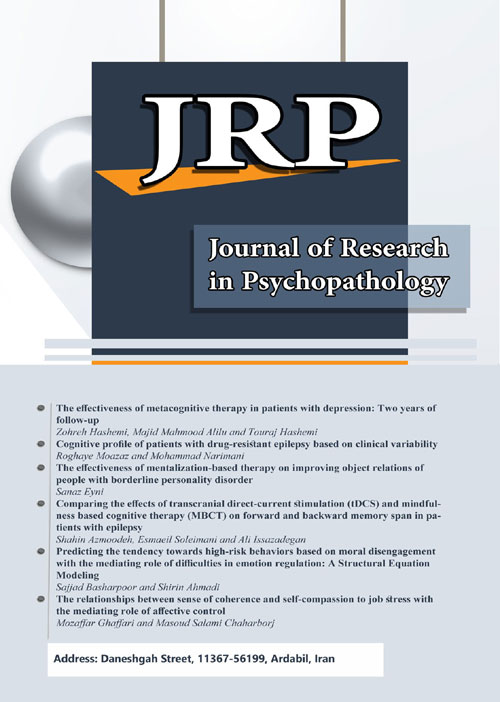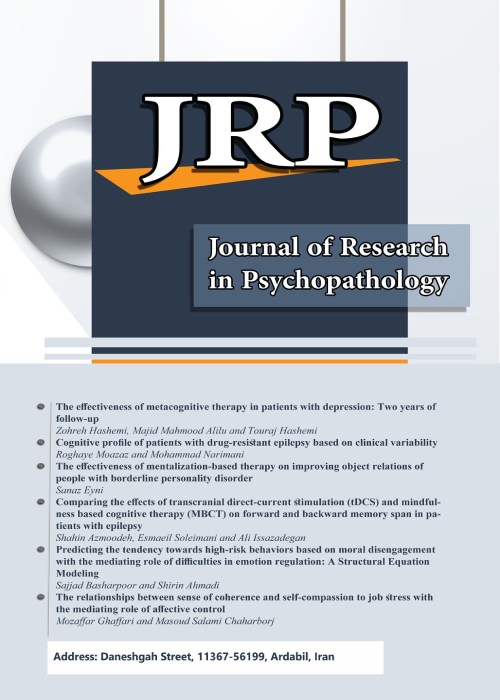فهرست مطالب

Journal of Research in Psychopathology
Volume:3 Issue: 9, Summer 2022
- تاریخ انتشار: 1401/06/13
- تعداد عناوین: 6
-
-
Pages 1-7This study aimed to present a regression model of sensitivity in interpersonal relationships based on concern about body image and relationship with the father. For this purpose, 292 first-year students of the Hazrat-e Masoumeh University of Qom in fall 2020 completed the Body Image Concern Questionnaire (BIC), Parent-Child Relationship Assessment Questionnaire (PCRS), and Symptom Checklist-25 (SCL-25) using a random sampling method. The data were analyzed using SPSS software version 25 and Smart PLS version 3 and the relevant model was analyzed by Pearson correlation and multivariate regression with the stepwise method in a descriptive-correlational study. Regression coefficients showed that body image concern and father-child relationship components could explain 0.31 of the variances of interpersonal sensitivity. Body image concern (Β = 0.43, t = 0.45), anger directed to father (β = 0.13, t = 2.41) and positive affect to father (β = -0.12, t = -2.29), could significantly explain female interpersonal sensitivity. The findings of the present study showed that prevention and intervention programs with an emphasis on improving body image and relationship with the father among female students can affect their mental health.Keywords: interpersonal sensitivity, Body image concern, Relationship with father
-
Pages 8-14The current study aimed to determine the effect of compassion-focused therapy on self-compassion and self-criticism in adolescents with body-image disorder. This quasi-experimental study was a pretest-posttest with the control group consisting of 30 adolescents with a body-image disorder based on a purposeful sampling selected and randomly allocated to experimental (n=15) and control (n=15) groups. The experimental group was provided with 10 one-week CFT sessions, while the control group did not receive any treatment. At the start of the study, after 10 weeks, all participants were tested using the Self-Compassion Scale and the Levels of Self-criticism (LOSC) Scale. In addition to descriptive statistics, MANOVA was used to analyze the results and all analyses were carried out using SPSS-23 software. Based on the MANOVA, CFT was significantly more effective than non-treatment in reducing self-criticism (p < 0.05). Moreover, CFT was able to increase the self-compassion levels among individuals with the body-image disorder, significantly (p < 0.05). Consequently, we can conclude that the practice of compassion-focused therapy seems to be a promising area of intervention, not only for decreasing self-criticism but also for enhancing self-compassion among adolescents with body-image disorder.Keywords: compassion-focused therapy, Self-compassion, Self-criticism Adolescent, Body-image disorder
-
Pages 15-27
The current study aimed at investigating the relationship of shyness and neuroticism with social anxiety taking into account the mediating role of effortful control. The research method was descriptive-correlation of structural equation modeling. The study population was all high school students (adolescents) in the cities of Tehran province who were studying in one of the public schools of these cities in the year 2021. The research sample was selected from the cities of Tehran province by multi-stage cluster sampling method (197 girls and 210 boys). Four standard questionnaires including Revised Cheek-Briggs Shyness Scale (1990), Short form of Five Personality Factors Questionnaire (2006), Social Anxiety Scale for Adolescents (1998) and Effortful Control Scale (2003) were used to collect data. Data were analyzed in two sections: descriptive statistics using SPSS23 software and inferential statistics using structural equation modeling in Amos software. The findings disclosed that only the relationship between shyness with social anxiety (β = 0.46, t = 5.081, sig = 0.000) and shyness with effortful control (β = -0.54, t = 5.985, sig = 0.000) were significant (Positively and negatively, respectively). Effortful control does not mediate the effect of neuroticism on social anxiety and the effect of shyness on social anxiety. Correspondingly, neuroticism has no effect on social anxiety. Conversely, the whole model comprising the combination of shyness, neuroticism, and effortful control variables could explain social anxiety (R2 = 27.4%) and the model had an acceptable fit.
Keywords: social anxiety, adolescents, effortful control, shyness, Neuroticism -
Pages 28-36
The aim of the present study was to investigate the effectiveness of compassion-focused therapy on thought fusion, ambivalence over emotional expression and impulsivity in married individuals with a history of suicide. This study was applied in terms of purpose and quasi-experimental in terms of method with pre-test and post-test design and control group. The population of this study includes all married individuals with a history of suicide whose disease was diagnosed by a specialist in the second half of 2020 to May 2021 referring to psychiatric centers in Sari to receive medical services. In this study, purposive non-random sampling was used. First, 50 individuals from the population were selected of whom 30 individuals were selected as a sample based on their scores in the questionnaires, and by random assignment, 15 individuals were placed in the experimental group and 15 individuals in the control group. Data collection included both library and field methods. In order to collect data, questionnaires of Beck Suicide (1961), Ambivalence over Emotional Expression (King & Emmons, 1990), Impulsivity (Barratt et al., 2004), and Thought fusion (Wells et al., 2001) were employed. Due to the standardization of questionnaires, their face validity was approved by the supervisors and consultants. The participants in the experimental groups received eight sessions of 70 minutes and two sessions per week for one month of compassion-focused therapy training interventions based on Gilbert (2018) treatment plan, while the control group did not receive any intervention. Data analysis was performed according to the assumptions and using SPSS software version 24, i.e. ANOVA and MANCOVA. The results showed that compassion-focused therapy is effective in thought fusion, ambivalence over emotional expression and impulsivity in married individuals with a history of suicide.
Keywords: Thought fusion, ambivalence over emotional expression, impulsivity, compassion-focused therapy, suicide -
Pages 37-44
This research aimed to investigate the effect of short-termsolution-focused couple therapy on irrational thoughts and marital adjustment of in compatible couples. This is a semi-experimental research with pretest and posttest control group. The study population consisted of all couples visiting Behzisti counseling centers in Rasht between 2019 to 2020. The sample for this study was Selected 16 couples and couples who wished to participate in the study were selected using convenience sampling, and randomly assigned to experimental and control groups. Tools used in this study included Spanier Dyadic Adjustment Scale (DAS) and Irrational Beliefs Test-Ahwaz (4 IBT-A). After random assignment of experimental and control groups, the experimental intervention (solution-focused therapy), was performed on the experimental group for 7 sessions of 90-minute once a week and after completing the training program, posttest was taken from both groups. The results of covariance analysis(univariate) of data showed that the solution-focused training through helping couples remind the days that they were compatible with each other and pointing to their past successful relationships resulted in increasing marital adjustment and also by encouraging them to positive talk, reduced irrational thoughts of couples in experimental group compared with the control group.
Keywords: solution-focused approach, marital adjustment, irrational thoughts, Couple therapy -
Pages 45-51
Problems caused by the overuse of cell phones have led to negative consequences in students' everyday life; Therefore, the present study was performed to investigate the predictive role of ambivalence over emotional expression and social self-efficacy in relation to cyber addiction tendency in students. The research method was descriptive-correlational and the research sample consisted of 250 high school students who were studying in Mashhad during the academic year 2020-2021, and participated in the research by Convenience Sampling method, internet-applied one, through social media by distributing the link of online questionnaire (online press), and responded to the Sevari Mobile Phone Addiction Scale (MPAS) (2014), Ambivalence over Emotional Expression Questionnaire (1990), And the Connolly Adolescent Social Self-Efficacy Scale (SSES) (1989). The collected Data were analyzed using Pearson correlation test and multiple regression analysis. The results showed that addiction to cyberspace has a negative relationship with social self-efficacy and a positive relationship with ambivalence over emotional expression. Therefore, psychologists should take necessary actions to reduce the severity of attachment on cyberspace in this vulnerable group of society by teaching them appropriate policies to reduce emotional, cognitive, and social problems in students.
Keywords: Addiction to cyberspace, ambivalence over emotional expression, social self-efficacy, Students


